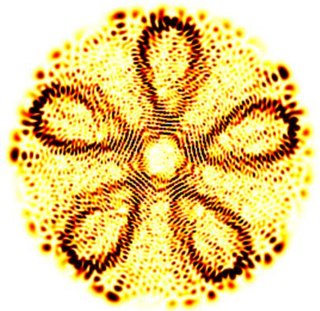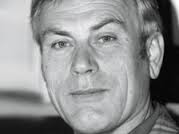Related Research Articles

Ivar Giaever is a Norwegian-American engineer and physicist who shared the Nobel Prize in Physics in 1973 with Leo Esaki and Brian Josephson "for their discoveries regarding tunnelling phenomena in solids". Giaever's share of the prize was specifically for his "experimental discoveries regarding tunnelling phenomena in superconductors".
A Bell test, also known as Bell inequality test or Bell experiment, is a real-world physics experiment designed to test the theory of quantum mechanics in relation to Albert Einstein's concept of local realism. Named for John Stewart Bell, the experiments test whether or not the real world satisfies local realism, which requires the presence of some additional local variables to explain the behavior of particles like photons and electrons. As of 2015, all Bell tests have found that the hypothesis of local hidden variables is inconsistent with the way that physical systems behave.

An optical parametric oscillator (OPO) is a parametric oscillator that oscillates at optical frequencies. It converts an input laser wave with frequency into two output waves of lower frequency by means of second-order nonlinear optical interaction. The sum of the output waves' frequencies is equal to the input wave frequency: . For historical reasons, the two output waves are called "signal" and "idler", where the output wave with higher frequency is the "signal". A special case is the degenerate OPO, when the output frequency is one-half the pump frequency, , which can result in half-harmonic generation when signal and idler have the same polarization.
A Josephson junction (JJ) is a quantum mechanical device which is made of two superconducting electrodes separated by a barrier. A π Josephson junction is a Josephson junction in which the Josephson phase φ equals π in the ground state, i.e. when no external current or magnetic field is applied.
This page deals with the electron affinity as a property of isolated atoms or molecules. Solid state electron affinities are not listed here.
A charge density wave (CDW) is an ordered quantum fluid of electrons in a linear chain compound or layered crystal. The electrons within a CDW form a standing wave pattern and sometimes collectively carry an electric current. The electrons in such a CDW, like those in a superconductor, can flow through a linear chain compound en masse, in a highly correlated fashion. Unlike a superconductor, however, the electric CDW current often flows in a jerky fashion, much like water dripping from a faucet due to its electrostatic properties. In a CDW, the combined effects of pinning and electrostatic interactions likely play critical roles in the CDW current's jerky behavior, as discussed in sections 4 & 5 below.
Universal conductance fluctuations(UCF) in mesoscopic physics is a phenomenon encountered in electrical transport experiments in mesoscopic species. The measured electrical conductance will vary from sample to sample, mainly due to inhomogeneous scattering sites. Fluctuations originate from coherence effects for electronic wavefunctions and thus the phase-coherence length needs be larger than the momentum relaxation length . UCF is more profound when electrical transport is in weak localization regime. where , is the number of conduction channels and is the momentum relaxation due to phonon scattering events length or mean free path. For weakly localized samples fluctuation in conductance is equal to fundamental conductance regardless of the number of channels.

Robert William Boyd is an American physicist noted for his work in optical physics and especially in nonlinear optics. He is currently the Canada Excellence Research Chair Laureate in Quantum Nonlinear Optics based at the University of Ottawa, professor of physics cross-appointed to the school of electrical engineering and computer science at the University of Ottawa, and professor of optics and professor of physics at the University of Rochester.
Surrogate data testing is a statistical proof by contradiction technique similar to permutation tests and parametric bootstrapping. It is used to detect non-linearity in a time series. The technique involves specifying a null hypothesis describing a linear process and then generating several surrogate data sets according to using Monte Carlo methods. A discriminating statistic is then calculated for the original time series and all the surrogate set. If the value of the statistic is significantly different for the original series than for the surrogate set, the null hypothesis is rejected and non-linearity assumed.

In quantum electrodynamics (QED), the Schwinger limit is a scale above which the electromagnetic field is expected to become nonlinear. The limit was first derived in one of QED's earliest theoretical successes by Fritz Sauter in 1931 and discussed further by Werner Heisenberg and his student Hans Heinrich Euler. The limit, however, is commonly named in the literature for Julian Schwinger, who derived the leading nonlinear corrections to the fields and calculated the rate of electron–positron pair production in a strong electric field. The limit is typically reported as a maximum electric field or magnetic field before nonlinearity for the vacuum of

Quantum scarring refers to a phenomenon where the eigenstates of a classically chaotic quantum system have enhanced probability density around the paths of unstable classical periodic orbits. The instability of the periodic orbit is a decisive point that differentiates quantum scars from the more trivial observation that the probability density is enhanced in the neighborhood of stable periodic orbits. The latter can be understood as a purely classical phenomenon, a manifestation of the Bohr correspondence principle, whereas in the former, quantum interference is essential. As such, scarring is both a visual example of quantum-classical correspondence, and simultaneously an example of a (local) quantum suppression of chaos.
A φ Josephson junction is a particular type of the Josephson junction, which has a non-zero Josephson phase φ across it in the ground state. A π Josephson junction, which has the minimum energy corresponding to the phase of π, is a specific example of it.

Dieter Pohl is a German–Swiss physicist. He became known especially for his pioneering works in nano-optics, near field optics (NFO), and plasmonics.

Antonio Barone was an Italian physicist. He was Emeritus Professor of the Federico II University of Naples and Director of the CNR Cybernetics Institute in Arco Felice (Naples), Italy. He is best known for his work on superconductivity and Josephson effect.

Sergej Flach is a theoretical physicist whose research has spanned a number of scientific fields in his career. With about 240 publications to his name, his research has been cited over 16,000 times giving him an h-index of 58 and i10-index of 174. He is a member of the American Physical Society, German Physical Society, Korean Physical Society, and New Zealand Institute of Physics. He is an editorial board member of Chaos (2016-) and was an editorial board member of Physical Review E (2009-2011).

David Tománek (born July 1954) is a U.S.-Swiss physicist of Czech origin and researcher in nanoscience and nanotechnology. He is Emeritus Professor of Physics at Michigan State University. He is known for predicting the structure and calculating properties of surfaces, atomic clusters including the C60 buckminsterfullerene, nanotubes, nanowires and nanohelices, graphene, and two-dimensional materials including phosphorene.

Amnon Aharony is an Israeli Professor (Emeritus) of Physics in the School of Physics and Astronomy at Tel Aviv University, Israel and in the Physics Department of Ben Gurion University of the Negev, Israel. After years of research on statistical physics, his current research focuses on condensed matter theory, especially in mesoscopic physics and spintronics. He is a member of the Israel Academy of Sciences and Humanities, a Foreign Honorary Member of the American Academy of Arts and Sciences and of several other academies. He also received several prizes, including the Rothschild Prize in Physical Sciences, and the Gunnar Randers Research Prize, awarded every other year by the King of Norway.
William H. Parker is an American professor of physics and academic administrator at the University of California, Irvine (UCI). Parker's earliest laboratory research involved seminal experiments that refined the precision of the measurements of fundamental constants. His later research focused on superconductors and other aspects of solid-state physics. In an administrative capacity at UCI, Parker has served in a variety of roles including as Dean, Department Chair, and Vice Chancellor.
Yvan J. Bruynseraede is a condensed matter experimental physicist, known for his work on multilayers and superlattices, and his interests are thin films, nanostructures, novel materials, magnetism, and superconductivity. He is currently Professor Emeritus at the Catholic University of Leuven (KULeuven), and a member of the Quantum Solid-State Physics Laboratory.
Dale J. Van Harlingen is an American condensed matter physicist.
References
- ↑ Haviland, David H. (augusti 2012). ”CV David H. Haviland” (på engelska). Läst 2013-10-12.
- ↑ Haviland, David B; Erik Tholen & Daniel Platz et al., "Intermodulation scanning force spectroscopy", PCT/EP2008/066247, DE112008003233T5, US20100312495 WO2009068568, publicerad Jun 4, 2009, utfärdad Nov 26, 2008
- ↑ Intermodulaton products
- ↑ Haviland, David H. (augusti 2012). ”List of publications David H. Haviland” (på engelska). Läst 2013-10-12.
- ↑ Gummeson, Christer (2008-02-25). ”Pressmeddelande: KVA belönar KTH-forskning”. Kungliga Tekniska högskolan. Läst 2013-10-12.
- ↑ "Researchers in physics and phonetics elected to the Academy". Royal Swedish Academy of Sciences. Retrieved 2019-08-07.